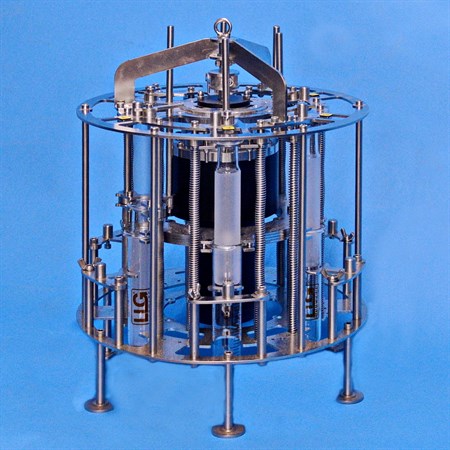
Small Multi Water Sampler 6 x 50 ml - Glass Syringes

100.204 - Small multi water sampler with Glass Syringes, 6 x 50
ml:
- General:
- This is a new model multi water sampler with 6 pcs 50 ml glass syringes. and is designed to operate at depths of up to 6000 meters.
- Operating voltage is between 12 and 24 V DC. Every time the motor gets a pulse it will release one syringe. As option, a time lapsed trigger can be attached. The motor is pressure compensated for 6000 m depth.
- The multi water sampler can be used on landers for taking samples from seabed or incubator chambers or placed on a ROV for taking samples over oil pipelines.
- Specifications:
- • Volume: 6 x 50 ml
• Deployment up to 12 months with the standard battery
• Reverse functionality (injection or suction function)
• Syringes: Glass
• AISI 316 stainless steel
• Finish: Electro polish
• Programmable trigger can be mounted (optional). Interface: USB
• Max. depth: 6000 m with battery 100.226 or 4000 m with 100.217
• Power supply: 24 V DC, current 1 Amp
• Comes without cables, trigger, battery cylinder, etc.
• Time to fill a syringe: 10 sec.
• Diameter: 330 mm
• Height, loaded: 420 mm
• Height, released:
• Weight: 13,7 kg excl. battery
Benefits of using glass syringes instead of plastic syringes
1. Superior Chemical Inertness and cleanliness
Glass syringes are exceptionally clean and sterile,
minimizing the risk of sample contamination. This is particularly
important in environmental sampling, where even trace contaminants
from the syringe material can compromise the validity of your
results.
Glass is chemically inert, making it less likely to react with or leach substances into your water samples compared to some plastics.
2. High gas and moisture barrier
Glass provides a much better barrier to gases (such as
oxygen) and moisture than plastic. This is crucial when sampling
for parameters like dissolved gases (e.g., O₂), as plastic syringes
can allow gases to diffuse in or out, potentially altering the
sample before analysis.
For example, studies have shown that oxygen can diffuse across plastic syringes 4-150 times more readily than glass, which can significantly affect results in sensitive analyses like blood gas or dissolved oxygen measurements.
3. Precision and Accuracy
Glass syringes generally have lower volume errors
(typically around 1%) compared to plastic syringes, which can have
errors as high as ±5%. This makes glass syringes preferable for
high-precision work and when handling small sample volumes.
The plunger-barrel fit in glass syringes is often individually ground for a leak-proof, smooth, and accurate operation, which is valuable for reproducible sampling and dispensing.
4. Reusability and long-term storage
Glass syringes can be cleaned, sterilized, and reused
multiple times, making them economical and environmentally friendly
for long-term projects.
They can also store samples for longer periods without risk of interaction or degradation, unlike plastic syringes, which are typically single-use and may not be suitable for long-term storage.
5. Suitability for sensitive analyses
Because of their inertness and gas barrier properties,
glass syringes are preferred for collecting samples for analyses
that are sensitive to contamination, gas exchange, or require
accurate preservation of the sample's original state (e.g., trace
metals, organics, or dissolved gases).
Glass syringes are preferred in multi water samplers when sample integrity, especially regarding chemical purity, gas content, and volume accuracy, is critical. They are best suited for laboratory or controlled field settings where their fragility is less of an issue, and their benefits for high-precision, contamination-free sampling outweigh their higher cost and handling considerations.